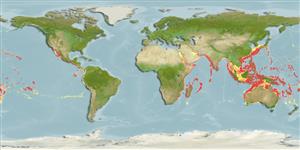Common names from other countries
Classification / Names / Names
Namen | Synonyme | Catalog of Fishes (gen., sp.) | ITIS | CoL | WoRMS
Environment: milieu / climate zone / depth range / distribution range
Ökologie
; tiefenbereich 5 - 918 m (Ref. 89006). Tropical
Indo-Pacific: from Red Sea to Melanesia, Micronesia and Polynesia.
Length at first maturity / Size / Gewicht / Alter
Maturity: Lm ? range ? - ? cm
Minimum depth from Ref. 101147. Living at depths of 30 m to 240 m (Ref. 89006). Found on shell rubble on sandy or muddy bottoms (Ref. 101147).
Life cycle and mating behavior
Geschlechtsreife | Fortpflanzung | Ablaichen | Eier | Fecundity | Larven
Members of the class Bivalvia are mostly gonochoric, some are protandric hermaphrodites. Life cycle: Embryos develop into free-swimming trocophore larvae, succeeded by the bivalve veliger, resembling a miniature clam.
Raines, B. and M. Huber. 2012. (Ref. 93550)
IUCN Rote Liste Status (Ref. 130435)
CITES Status (Ref. 108899)
Not Evaluated
Not Evaluated
Bedrohung für Menschen
Harmless
Nutzung durch Menschen
| FishSource |
Tools
Mehr Information
Alter/Größe
Wachstum
Länge-Gewicht
Länge-Länge
Morphologie
Larven
Dichte
Internet Quellen
Estimates based on models
Preferred temperature
(Ref.
115969): 9.6 - 21.6, mean 15 (based on 576 cells).
